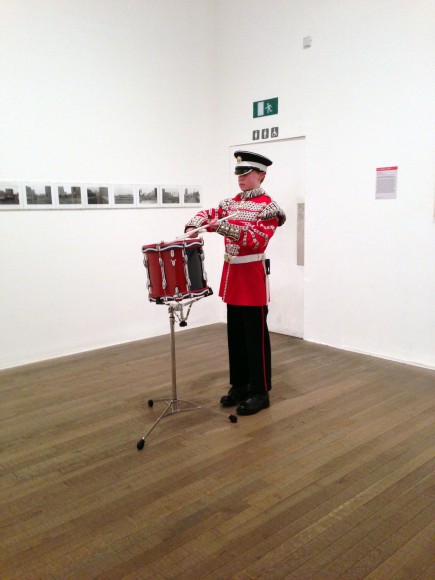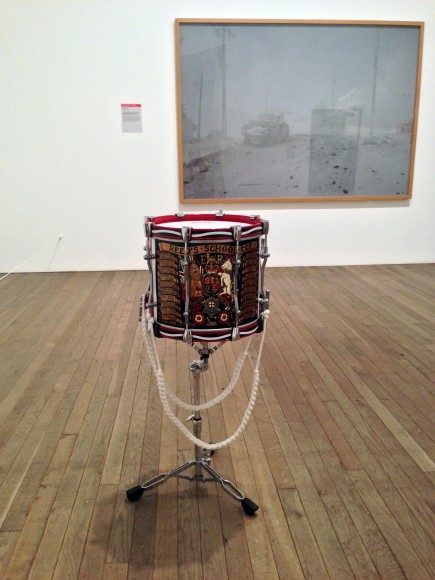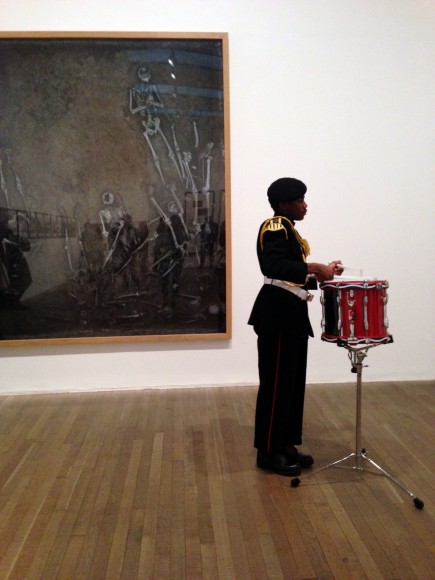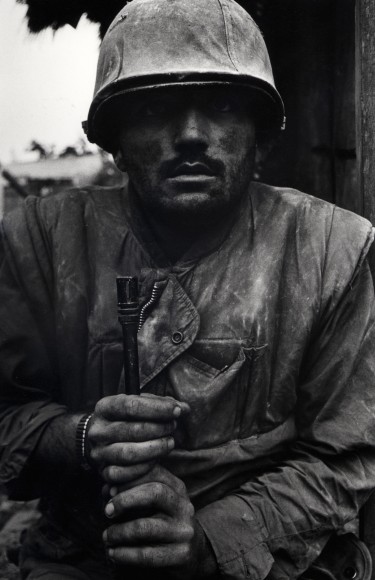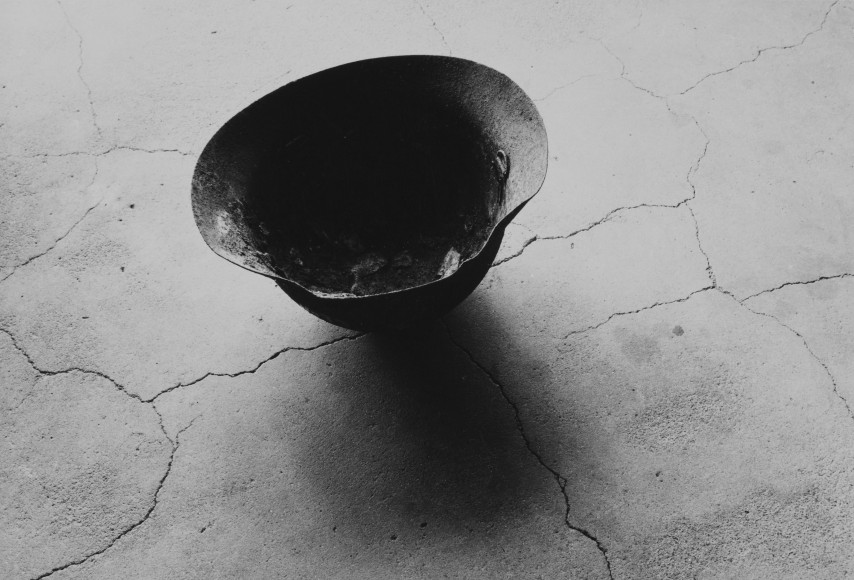In each room of Conflict, Time, Photography at Tate Modern a drum has been strategically placed on a stand. Silent, these drums foretell of action to come, a potent addition to the photographs on display, which in contrast document the aftermath of war. Some of the drums are plain red; others are decorated, hand-painted with a lion and a unicorn.
The audience are welcomed in to view the exhibition, but we’re not told when or where the performance will start. My anticipation distracts me from looking at the work. People mill from room to room, obviously a little uneasy too, anxious to see what will happen next, anxious to be in the right place at the right time.
When I’ve almost walked to the end of the exhibition, shouted commands and the stomping of feet sound out. These are alien, jarring sounds in a place where usually you would only hear hushed exchanges, the occasional, ostentatiously loud remark, or the chatter and squeals of school children. The exit doors swing open to reveal a battery of army cadets, aged between 14 and 17, each holding a pair of drumsticks and wearing full dress uniform with severe expressions to match.
The cadets march in, led by a stern Lieutenant, who punches out commands that coordinate their steps: left, right, left, right (although his forceful delivery makes it a more staccato: heftrite heftrite heftrite.) I’m mesmerised by the shining buttons, the braids, the epaulets, the fleur-de-lis detailing; the red, the blue, the yellow, the gold, the pomp and regalia. Half the cadets are in red, half in dark blue. I’m not sure what this means, different units, different ranks? The red uniform includes a knife hanging from the belt.
When the line passes a drum, the last cadet takes up position behind it. They start rat-tat-tatting in rhythm with their companions who are now marching away. This parade through the exhibition continues until each drum is occupied.
I’ve never been to a military tattoo, never seen the changing of the guards (unless by mistake, in passing), I don’t know the correct terminology for what I see. This world is unfamiliar to me, and I don’t know how to interpret this display other than with my gut, the way the shouted commands and drumming makes me feel. Nervous, on edge, a little excited.
The drumming is loud and monotonous, making it hard to concentrate on or even look at anything else in the room. Traditionally drums were used on the battlefield to communicate messages and synchronise firing, over the sounds of battle. Until the late nineteenth century young boys often carried out this role. The little drummer boy took on an almost mascot-like status for soldiers, and the appeal of being in this position of esteem would inspire young boys to run away and join the army. I wonder at the purpose of the drumbeat now. Usually these cadets would march drumming is unison. Here, apart, isolated, they continue the performance, a display of their discipline and skill.
A relay starts (there must be spare cadets waiting outside the exhibition to keep the loop going.) A drummer approaches, and begins to beat the drum already occupied. Four sticks tapping together one taught skin. There is a choreographed exchange; a shuffling of places and the first drummer is dismissed to march on to the next drum down the line.
The cadets are sponsored by the army, but there is no requirement that they enter the military when old enough. The description on their website make it sound like a fun afterschool club, or a way to keep young people ‘out of trouble’, giving them “access to fun, friendship, action and adventure…” and an opportunity “to learn more, do more and try more… to aim high, and gain skills, values and attitudes to go further in life.” They play sport, learn orienteering, get to go on a camp in the summer, but they also learn to wear a uniform with pride, march as part of a team and shoot rifles. Apparently 81 per cent of cadets join because of this last activity.
Now that the cadets have been left drumming alone in the exhibition, surrounded by images of the aftermath of war, they look vulnerable. One boy in particular has too-long sleeves and peers out from under the too-low peak of his hat, his cheeks flushed—a tin toy-soldier hanging from the Christmas tree. For some the drums seem to be positioned too high, and their arms are raised awkwardly at the shoulder in order to strike.
I’m fascinated by the imperfections of the performance. When the switchovers get a bit messy, when the back is not quite held straight enough, when the drumming goes a little out of sync. Some eyes dart nervously around the room. Blank expressions break, revealing discomfort and self-consciousness in front of this art crowd who are staring and taking photos.
I notice the mother of one girl (a large portion of the audience is formed of proud relatives) follow her to each new position taking photos. The mother beams with pride and the daughter squirms in teenage embarrassment, slowly shaking her head “No” as the mother’s phone is held up for one more shot.
The performance is a manifestation of War Primer II, an artist book produced by Adam Broomberg and Oliver Chanarin in 2013, which inhabits the pages of Bertolt Brecht’s 1955 publication War Primer. The artists screen printed images of the War on Terror sourced from the internet over the original photographs narrating the Second World War which Brecht had collected from the illustrated press. Under each of the photographs Brecht wrote four line epigrams that were left unaltered by Broomberg and Chanarin. In 1957 a selection of these epigrams were set to music by Hans Eisler, a composer who often collaborated with Brecht, as the beginning of a War Primer opera. Never completed, this work was the inspiration for this performance. Here, rather than choosing images from the press or the internet, the drums are positioned next to, or nearby, photographs within Conflict, Time, Photography, which Broomberg and Chanarin have selected to be newly activated by Brecht’s epigrams.
The lieutenant returns, marches to stand beside each drummer and deliver a four-line stanza. He barks them like they are commands; it’s hard to discern the words above the racket of the drum. They are also printed in a leaflet alongside the photographs Broomberg and Chanarin want them to be associated with, and reading them more effectively prompts a critical consideration of the relationship between photography and language, one of Brecht’s aims in War Primer.
I’m reminded of another work by Broomberg and Chanarin, made whilst they were embedded with the British army in Afghanistan. In The Day Nobody Died, 2008, they co-opted the army into carrying a cardboard box containing a large role of light sensitive paper. This paper was exposed to create abstract photograms at moments that traditionally would be considered ‘photo opportunities’. (One of these photograms is displayed in the exhibition.) Throughout the trip they filmed the cardboard box—being carried by soldiers, loaded in and out of vehicles, waiting in mess tents—and this documentation reveals what they describe as an absurd performance. By inviting cadets into this exhibition to perform, Broomberg and Chanarin remind us of the ceremony and the tradition, but also the spectacle integral to the military, and the increasingly dominant role the creation of spectacular images plays in the way war is fought.
Conflict, Time, Photography is at Tate Modern until 15 March 2015.
War Primer II: One Way Song, a performance by Adam Broomberg and Oliver Chanarin in collaboration with the Army Cadet Force took place in the galleries of the Tate Modern on 26 January 2015.

